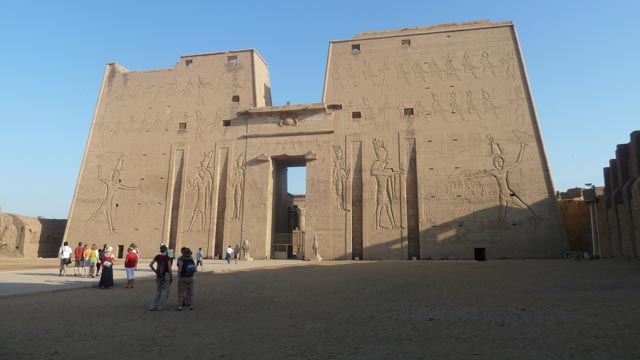This is the first post about the Temple of Horus in Edfu. We visited the Temple at Edfu early in the morning of the 19th October 2011 as part of a tour group of 8 people – 4 from Australia and 4 from Canada. We had a very knowledgeable Egyptian Tour Guide. Thanks Khaled.
This series on Edfu Temple covers
- Introduction
- History of the Temple
- What there is to see
- How to get there
- An overview of our experience

Edfu Temple – Introduction
The Temple of Horus in Edfu (also known as the Temple of Edfu) is considered the best-preserved cult temple in Egypt. Built in the Ptolemaic era from 237 to 57 BC, it reflects the traditional pharaonic architecture and provides a fairly accurate view of how the temples used to look.
Edfu Temple is the second largest Temple in Egypt (Karnak Temple in Luxor is larger).
Edfu is about half way between Aswan and Luxor. We arrived in Edfu on a Nile River Cruise and we had a early morning start leaving our boat and travelling through the township on a calèche (a two-wheeled horse-drawn vehicle) to Edfu Temple.
The ride through the town was interesting looking at the street life of the Egyptian community, the shops and the people – Children going to school, people shopping and going to work.
Map of the Temple

Edfu Temple – History
It doesn’t seem to matter which Temple you go to, Horus appears there in some shape or form. Edfu Temple was the temple of Horus and there are many representations of Horus – as a falcon. Pharaohs considered themselves to be the living incarnation of Horus. The hieroglyphics show the representation of a man with a Falcon head emphasizing the point that the pharaohs consider themselves to be Horus!!
The Temple of Horus at Edfu was built from 237 to 57 BC on top of an earlier temple to Horus, which was oriented east-west instead of the current north-south configuration.
The oldest part of the temple is the section from the Festival Hall to the Sanctuary; this was begun by Ptolemy III in 237 BC and completed by his son, Ptolemy IV Philopator. The Hypostyle Hall was added by Ptolemy VII (145-116 BC) and the pylon was erected by Ptolemy IX (88-81 BC). The final touches to the temple were added under Ptolemy XII in 57 BC.
The falcon-headed Horus was originally the sky god, whose eyes were the sun and moon. He was later assimilated into the popular myth of Isis and Osiris as the divine couple’s child. Raised by Isis and Hathor after Osiris’ murder by his brother Seth, Horus avenged his father’s death in a great battle at Edfu. Seth was exiled and Horus took the throne, Osiris reigning through him from the underworld.
The Temple of Edfu was abandoned after the Roman Empire became Christian and paganism was outlawed in 391 AD. It lay buried up to its lintels in sand, with homes built over the top, until it was excavated in the 1860s. The sand protected the monument over the years, leaving it very well preserved today.

For more information about Edfu Temple
- 2014-03-19 – Esna – Kom Ombo – Aswan
- Edfu Temple – Part 2
- Edfu Temple – Part 3
- Edfu Temple – Part 1
- Egyptian Mythology – Horus
